Advances in Animal and Veterinary Sciences
Research Article
Advances in Animal and Veterinary Sciences. 2 (1): 56 – 62Sire Evaluation Considering First Lactation Yield for Improvement of Life Time Production in Sahiwal and Crossbred Cattle
Prem Prakash Dubey1, ChandraVir Singh2*
2. Department of Animal Genetics and Breeding, College of Veterinary and Animal Science, Govind.Ballabh. Pant University of Agriculture & Technology, Pantnagar–263 145 (Udham.Singh.Nagar)
*Corresponding author: cvsingh2010@gmail.com
ARTICLE CITATION: Dubey PP and Singh CV (2014). Sire evaluation considering first lactation yield for improvement of life time production in Sahiwal and crossbred cattle. Adv. Anim. Vet. Sci. 2 (1): 56 – 62.
Received: 2013–11–26, Revised: 2013–12–23, Accepted: 2013–12–23
The electronic version of this article is the complete one and can be found online at (http://dx.doi.org/10.14737/journal.aavs/2014.2.1.56.62) which permits unrestricted use, distribution, and reproduction in any medium, provided the original work is properly cited
Abstract
The performance records of 587 Sahiwal and crossbred cattle daughters of 47 sires maintained during 1970 –o 2001 at Instructional Dairy farm, G.B. Pant University of Agriculture & Technology, Pantnagar, were used to evaluate sires for first lactation and life time performance traits. First lactation traits included were age at first calving, first lactation milk yield, first lactation period, first dry period, first calving interval, and first service period. Life time traits were herd life, productive life, lifetime milk yield, total lactation length and life time milk yield /day of productive life. The Least Squares method was used to obtain the estimates of breeding values. The estimated breeding values (EBVs) of sires showed large genetic variation between sires for both first lactation and life time traits. The product moment correlations among the EBVs of sires for first lactation traits were ranged from very low to moderate. The first lactation traits also showed same trend with life time performance traits. While product moment correlations among estimated breeding values of sires for life time traits were medium to very high. The rank correlation between the EBVs of sires for first lactation traits ranged from –025 to 0.60. The range of rank correlation among EBVs for life time traits was found to be –0.17 to 0.88. The rank correlations between EBVs of sires for first lactation traits with life time performance traits ranged from –0.28 to 0.38 respectively. Rank correlation among EBVs of sire’s indicated that all sire’s would not rank same for first lactation and life time performance traits. However, the ranks of sire’s for different traits revealed that 4–5 % top sire’s had similar rank for first lactation and life time performance traits. These results suggested that to improve lifetime productivity major culling of bulls should be done on the basis of their daughter’s first lactation milk yield.
Introduction
The evaluation of sire has been of prime importance from long past. The estimation of breeding values constitute an integral part of most breeding programmes for genetic improvement of sires for different productive and reproductive traits. Traditionally, the breeding value was estimated as the individual or progeny deviation from contemporary performance within an environment. In dairy cattle breeding, the selection of sire for milk yield is the most important aspect of genetic improvement (Raheja, 1992). Sire evaluation programmes are also essential because the majority of genetic improvement can be attained through the selection of males rather than selection of females. Relationship between sire’s breeding value for first lactation traits and life time performance traits in dairy cattle is important in determining whether accommodation to select dairy sire’s based on performance of their daughter’s first lactation would improve the total life time production or not. In view of the above consideration, it was planned to employ least squares method to estimate the breeding value of sires for first lactation and life time performance traits to determine relationship among estimates of sire’s breeding value.
MATERIALS AND METHODS
The performance records of 587 (Sahiwal, Sahiwal Χ Jersey, Sahiwal Χ Holestein Frisian, Sahiwal Χ Red Dane, and Sahiwal Χ Rathix Holestein Friesian)daughter of 47 sires, maintained at Instruction Dairy Farm of G.B.Pant University of Agriculture & Technology, Pantnagar, during 1970–2001 were used to estimate sire’s breeding value for first and lifetime performance traits. Cows with abnormal and incomplete record were excluded from the analysis. Each year was divided into there seasons, viz summer (March to July), rainy (August to October) and winter (November to February) based on climatological conditionsof the region. Sires were grouped into 5 sire’s genetic group on the basis of period in which their first daughter was born. First lactation traits included in this study were age at first calving, first lactation milk yield, first lactation period, first dry period, first calving interval and first service period. Lifetime traits were herd life, lifetime milk yield, productive life, total lactation length and lifetime milk yield /day of productive life. The herd life was defined as the period between first calving to the date of disposal or the sixth calving if the cow remained in the herd. Total amount of milk produced by a cow from the initiation of first lactation till last day in milk in the herd or total up to 5 lactations was taken as lifetime milk yield. Productive life was defined as total number of days from first calving to the date of disposal or last dry date if the cow remained in the herd up to completion of 5 lactations. Total lactation length was defined as total number of days in milk in the different lactations in the same herd. Cow with less then two lactations were excluded for studying the lifetime traits. Breeding values of sires for first lactation and life time traits were estimated by Least Squares Model (Harvey, 1990) considering sire as random effect, period and season of calving and genetic groups as fixed effects. The following linear model was used to isolate fixed effects. Yijklm: µ + Si + yj + Bk + Pl + eijklm Where, Yijklm: observation on mth progeny of ith sire belong to kth breed jth period and lth season of calving µ = over all mean Si, Yj and Bk, the fixed effects of season, period of calving and breed respectively Pl = random effect of sire. The estimated breeding value of sire for each trait was taken as twice the sire genetic group solution plus sire solution within sire genetic group for that trait. The product moment and rank correlation among sire’s estimated breeding values of different traits was calculated according to Steel and Torrie (1980).
RRESULT AND DISCUSSION
The estimated breeding values (EBVs) by Least Squares procedure of sires along with their ranks for first lactation and lifetime traits are given in the Table l and 2. The estimated breeding values of sires showed large genetic variation between sires for first lactation traits. The estimated breeding values (EBVs) for sires ranged from –161 to 232 days for age at first calving, –1181 to 1594 kg for first lactation milk yield, –35 to 124 days for first lactation period, –42 to 52 days for first dry period, –117 to 331 for first service period respectively. Dalal et al. (1999) also reported large genetic differences between breeding values of sires for first lactation traits. Large genetic variation
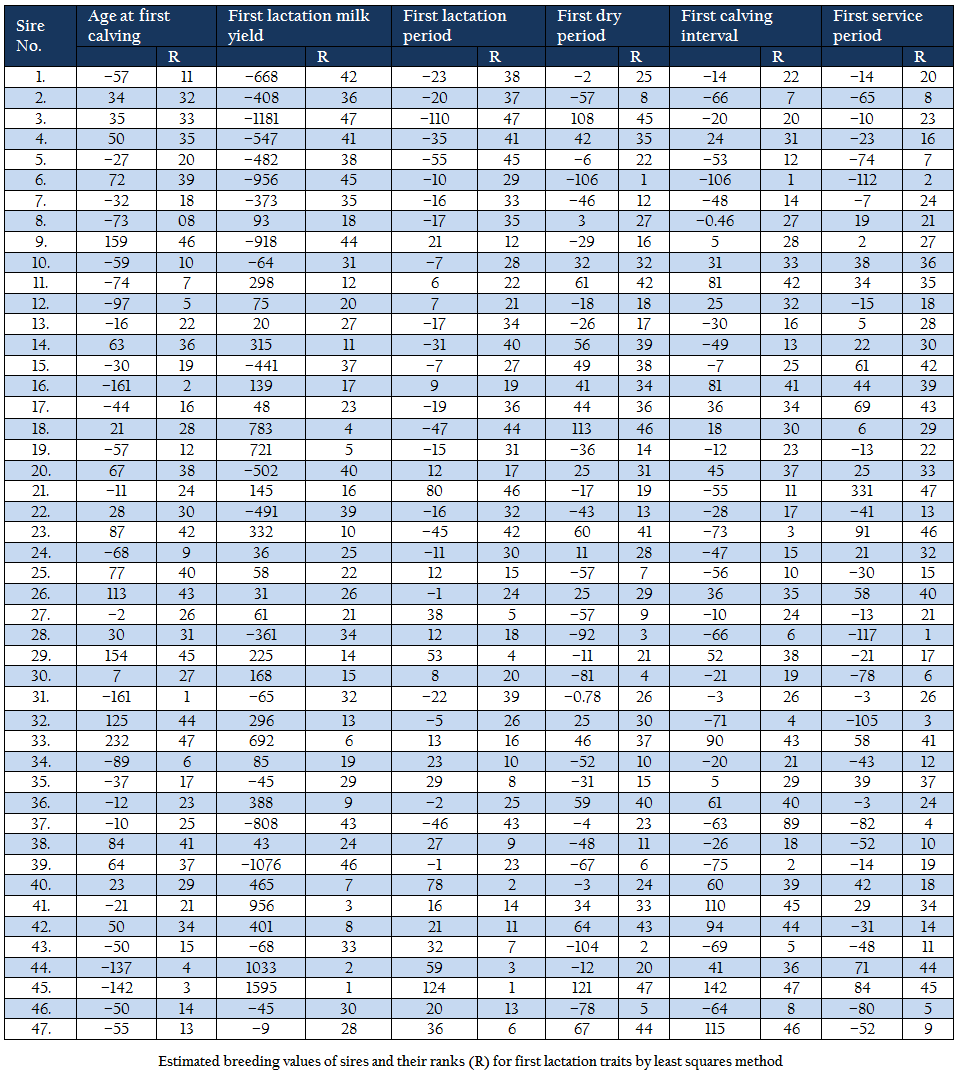
Table 1:Estimated breeding values of sires and their ranks (R) for first lactation traits by least squares method
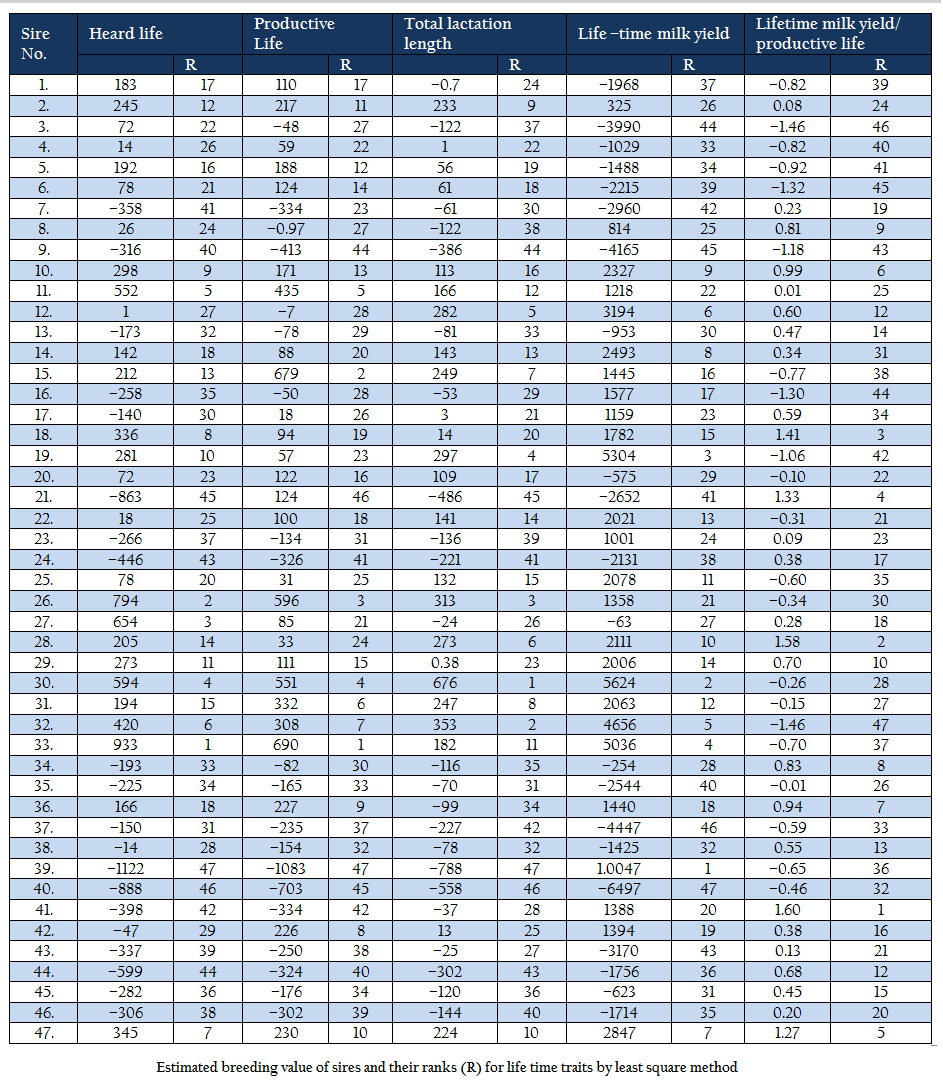
Table 2:Estimated breeding value of sires and their ranks (R) for life time traits by least square method
was also observed between the estimated breeding values of sires for lifetime performance traits. The estimated breeding values for herd life ranged from –278 to 198 days. Productive life –1088 to 690 days, total lactation length –788 to 676 days, life time milk yield –6497 to 10047 kg. and lifetime milk yield per day of productive life –1.46 to 1.60 kg.Dalal et al. (1999) also reported large genetic variation between the breeding values of sires for lifetime production traits.
In general, EBVs for sires did not showed any systematic trend of first lactation traits as well as for life time performance traits. In the present investigation the estimated breeding values of sires for first lactation and life time performance traits showed large variation between EBVs of sires, which revealed more genetic variation in the herd. This might be due to fact that this herd had no. of genetic groups and maintained as close herd and animals with low production might have not been culled from the herd. The large variation in the estimated breeding values might be due to procedure used for estimating the breeding values of sires. Tajane and Rai (1990) ranked Sahiwal and Holstein Friesian sires using LS and BLUP method and reported that BLUP method was the best method. Raheja (1992) also evaluated Sahiwal sires using D, LS and BLUP methods and reported that LS and BLUP methods were the most accurate method, but LS to be more accurate than BLUP when variance is not known, Gaur and Raheja (1996) reported that LS was more accurate than the BLUP method. Deulkar and Kothekar (1999) reported that D method was equally good when compared with LS and BLUP methods. However, it has been reported that EBVs estimated by BLUP method showed small genetic variation in comparison to Least Squares method because of its derivable properties (Dhaka and Raheja,2000; Dahia,2003; Dubey et al. ,2004). Moreover several geneticist reported BLUP is the best procedure in comparison to other procedures of sire evaluation (Bajeetha, 2006; Dubey et al., 2006; Moges et al., 2009; Singh and Singh, 2011).
The product moment correlations among the EBVs of sires for first lactation and life time performance traits by Least Squares method are presented in Table 3, 4 and 5. The estimated breeding values of sires for age at first calving had negative product moment correlations with EBVs of sires for first lactation milk yield, first lactation length, first dry period, first calving interval and first service period respectively, whereas, positive product moment correlations of EBVs of sires were found with all the life time performance traits (Table 3)
Positive product moment correlation between sire’s estimated breeding values for AFC and life time production traits indicated that AFC can be used for estimating the breeding values of sires for life time production traits. Product moment correlation between sire’s breeding value for first lactation milk yield with first lactation period, first dry period, first service period, first calving interval, herd life, productive life, total lactation length, life time milk yield and total milk yield days, productive life were positive and ranged from 0.05 to 0.55.
Product moment correlation between sire’s breeding values for first lactation period with first calving interval, lifetime milk yield and total milk yield/day of productive life were positive, while between first lactation period and first dry period, first service period, herd life, productive life and total lactation length were negative. Product moment correlation between sire’s breeding values of sires for first service period with first calving interval and total milk yield and days of productive life were positive while correlation between estimated breeding values for herd life, productive life, total lactation length and life time milk yield were negative.
The correlation between estimated breeding values of sire’s for first calving interval with the life time production traits were found positive and their values ranged from 0.05 to 0.25. The correlation between estimated breeding values of sire’s for herd life with productive life, total lactation length and life time milk yield were highly positive, while negative was estimated with lifetime milk yield/day of productive life. The product moment correlation between estimated breeding values of sire’s for productive life with total lactation length and life time milk yield were highly positive but negative correlation was observed with total milk yield /day of productive life.
The product moment correlation of estimated breeding values of sire’s for total lactation length was positive with life time milk yield, while negative correlation was observed with life time milk yield / day of productive life. The product moment correlation of estimated breeding values of sires for life time milk yield with life time milk yield/day of productive life was positive. Similar results were also reported by Pundir and Raheja (1994) in Hariana and Sahiwal cattle, Deulkar and Kothekar (1999) in Sahiwal and Dalal et al. (1999) in Hariana cattle.
The rank correlations among the EBVs of sires for first lactation production traits ranged from –0.25 to 0.60. The rank correlation among EBVs for life time traits were ranged frim –0.17 to 0.88. The rank correlations between the EBVs of sires for first lactation traits with life time performance traits ranged from –0.28 to 0.38 (Table 5). The rank correlations between estimates of breeding values of sires based on first lactation traits and life time performance traits were less than 1, This indicated that sire ranking would change from first lactation to life time performance traits and therefore, sire should be evaluated for first time performance of their daughters to bring genetic improvement in life time productivity. The major objection to evaluate sire’s based on life time production traits has been increased generation interval and thereby slowing down genetic progress.
The rank of sire’s for first lactation and life time traits against their EBVs (Table–1 and 2) indicated that all sire’s would not rank same for all traits. However, the rank of sire’s for different traits revalued that 4 –5 % of top sire’s almost has similar rank for first lactation and life time traits. Sire evaluation is generally aimed at selecting first few top ranking sire’s.
Sire’s of top 5 ranks on the basis of EBVs of sire’s for first lactation and life time performance traits are also presented in Table 4 and showed that the rank for all the sire’s are not similar for all the traits.
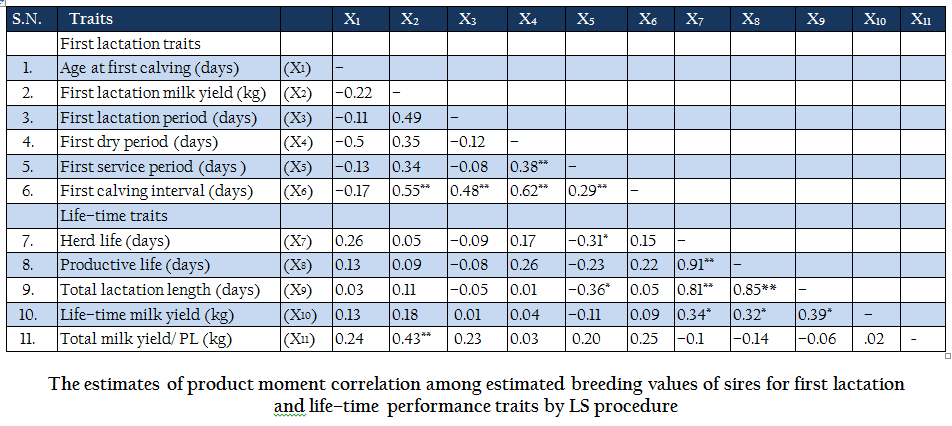
Table 3:The estimates of product moment correlation among estimated breeding values of sires for first lactation and life–time performance traits by LS procedure
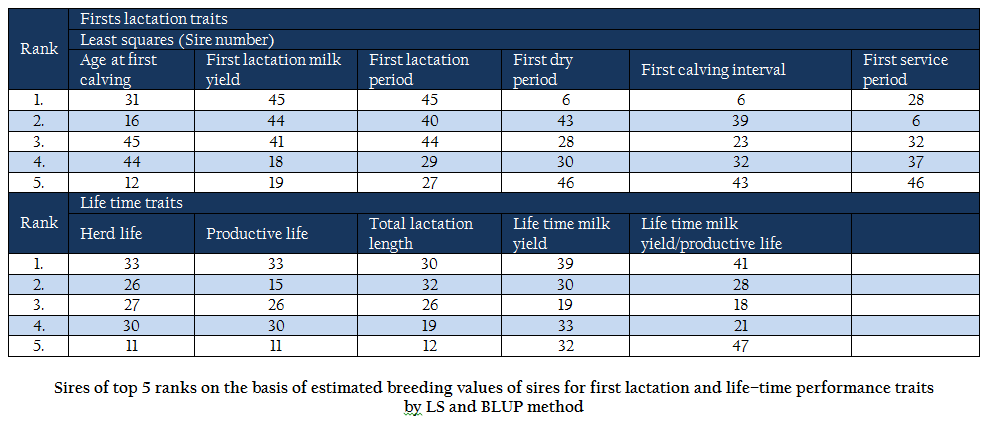
Table 4:Sires of top 5 ranks on the basis of estimated breeding values of sires for first lactation and life–time performance traits by LS and BLUP method
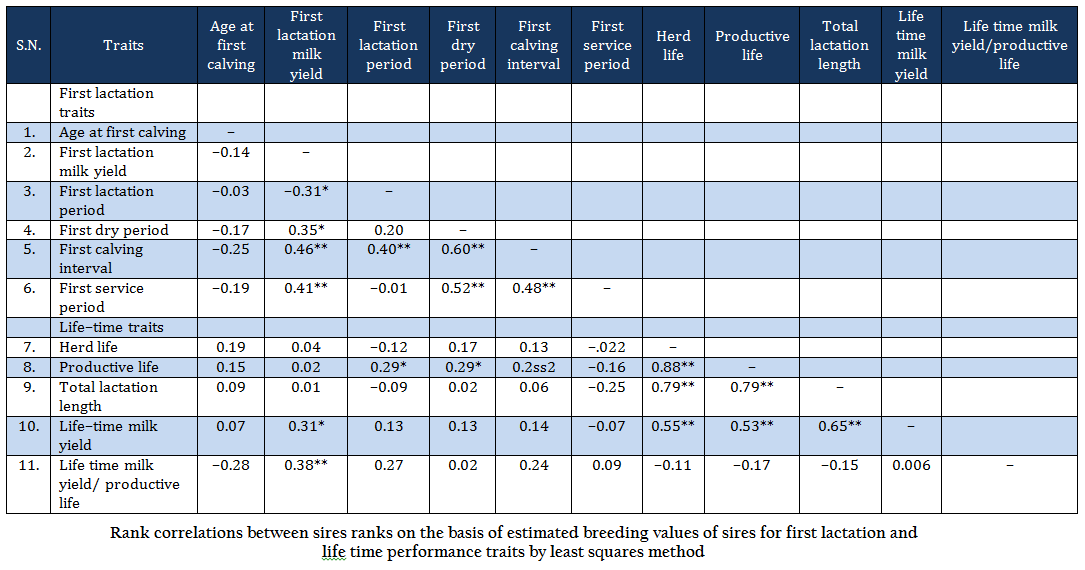
Table 5:Rank correlations between sires ranks on the basis of estimated breeding values of sires for first lactation and life time performance traits by least squares method
These results suggested that sire ranking would change from first lactation to lifetime performance traits and therefore, sire should be evaluated for first time performance traits of their daughters to bring genetic improvement in life time productivity. For improvement of life time productivity major culling of bulls should be done on the basis of their daughter’s first lactation milk yield.
REFERENCES
Bajetha G. 2006. Selection of sires by using different sires evaluation methods in crossbred cattle. Ph.D. Thesis, G.B. Pant University of Agriculture & Technology, Pantnagar, U. S. Nagar, Uttarakhand
Dahia D S, Singh R P and Khanna A S. 2003. Genetic group differences and the effect of non genetic factors in crossbred cattle for reproduction traits. Indian Journal of Animal Research. 37 (1): 61–64.
Dalal D S, Rathi S S and Raheja K L. 1999. Relationship between sire’s estimated breeding value for first lactation and life time performance traits in Hariana cattle. Indian Journal of Animal Science. 64 (4): 592 –595.
Deulkar PB and Kothekar M D. 1999. Sire evaluation considering first lactation yield for improvement of life time production in Sahiwal. Indian Journal of Animal Science, 69(4): 240 – 242.
Dubey P P. 2004. Comparison of different Sire evaluation methods used in dairy cattle. M.Sc Ag. Thesis. G B Pant University of Agri. & Tech. Pantnagar, U.S.Nagar.
Dubey P P, Singh C V and Prasad R B. 2006. Relationship between sires estimated breeding values for first lactation and lifetime traits and ranking of sires in Sahiwal and its cross. Indian Journal of Animal Sciences. 76 (10): 824–828.
Gaur G K and Raheja K L. 1995. Relationship among estimates of sire’s breeding value for part and 300 days milk yield. Indian Journal of Animal Science. 66 (4): 366–370.
Harvey W R. 1990. User guide for LSMLMW and MIXMDL package. Mix model Least Squares and Maximum Likelyhood Computer Programme. Pc–2 version. Mimeograph. Columbia, chio, USA.
Moges T G, Singh C V, Barwal R S, Kumar D and Singh C B. 2009. Evaluation of sires using different multipart sire evaluation methods in crossbred cattle. Indian Journal of Dairy Science. 62 (3): 1–4.
Pundir R K and Raheja K L. 1994. Relationship between sire’s estimated breeding values for first lactation and life time traits in Sahiwal and Hariana cattle. Indian Journal of Animal Science. 45(2): 64 – 69.
Raheja K L. 1992. Comparison of progeny testing of Sahiwal sires by the different methods of sire evaluation. Indian Journal of Dairy Science. 45(2):64–69.
Singh V K and Singh C V. 2011. Sire evaluation using animal model and conventional methods for milk production in crossbred cattle. Indian Journal of Animal Sciences. 81 (1): 77–79.
Steel R G D and Torrie J H. 1980. Principles and procedures of Statistics. 2nd ed. MCGRAW Hill book co. Newyork.
Tajane K R and Rai A K. 1990. Efficiency of Sire evaluation methods to improve milk yield of Sahiwal X Holstein Frisian cattle, Indian Journal of Animal Science. 60:1872–191




